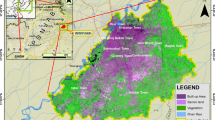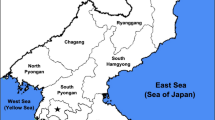Abstract
In this study, we used fire count datasets derived from Along Track Scanning Radiometer (ATSR) satellite to characterize spatial patterns in fire occurrences across highly diverse geographical, vegetation and topographic gradients in the Indian region. For characterizing the spatial patterns of fire occurrences, observed fire point patterns were tested against the hypothesis of a complete spatial random (CSR) pattern using three different techniques, the quadrat analysis, nearest neighbor analysis and Ripley’s K function. Hierarchical nearest neighboring technique was used to depict the ‘hotspots’ of fire incidents. Of the different states, highest fire counts were recorded in Madhya Pradesh (14.77%) followed by Gujarat (10.86%), Maharastra (9.92%), Mizoram (7.66%), Jharkhand (6.41%), etc. With respect to the vegetation categories, highest number of fires were recorded in agricultural regions (40.26%) followed by tropical moist deciduous vegetation (12.72), dry deciduous vegetation (11.40%), abandoned slash and burn secondary forests (9.04%), tropical montane forests (8.07%) followed by others. Analysis of fire counts based on elevation and slope range suggested that maximum number of fires occurred in low and medium elevation types and in very low to low-slope categories. Results from three different spatial techniques for spatial pattern suggested clustered pattern in fire events compared to CSR. Most importantly, results from Ripley’s K statistic suggested that fire events are highly clustered at a lag-distance of 125 miles. Hierarchical nearest neighboring clustering technique identified significant clusters of fire ‘hotspots’ in different states in northeast and central India. The implications of these results in fire management and mitigation were discussed. Also, this study highlights the potential of spatial point pattern statistics in environmental monitoring and assessment studies with special reference to fire events in the Indian region.
Similar content being viewed by others
References
Agee, J. K. (1993). Fire ecology of Pacific Northwest forests. Washington, D.C.: Island Press.
Baker, W. L., & Kipfmueller, K. F. (2001). Spatial ecology of Pre-Euro-American Fires in a Southern Rocky Mountain Subalpine Forest Landscape. Professional Geographer, 53(2), 248–262.
Besag, J. (1977). Contribution to the discussion of Dr Ripley’s paper. Journal of the Royal Statistical Society, B39, 193–195.
Bartholome, E., Belward, A. S., Achard, F., Bartalev, S., Carmona-Moreno, C., Eva, H., et al. (2002). Global land cover map** for the year 2000. European Commission. JRC. 2002. http://www.gvm.jrc.it.
Burgan, R. E., Klaver, R. W., & Klaver, J. M. (1998). Fuel models and fire potential from satellite and surface observations. International Journal of Wildland Fire, 8(3), 159–170.
Census of India (2001). http://www.censusindia.net/.
Champion, H. G., & Seth, S. K. (1968). A revised survey of the forest types of India. Delhi: Government of India Press.
Chou, Y. H., Minnich, R. A., & Dezzani, R. J. (1993). Do fire sizes differ between southern California and Baja California? Forest Science, 39, 835–844.
Christensen, P., & Abbott, I. (1989). Impact of fire in the eucalypt forest ecosystem of southern Western Australia: A critical review. Australian Forestry, 52, 103–121.
Chuvieco, E., & Salas, J. (1996). Map** the spatial distribution of forest fire danger using GIS. International Journal of Geographic Information Systems, 10, 333–345.
Clark, P. J., & Evans, F. C. (1954). Distance to nearest neighbor as a measure of spatial relationships in populations. Ecology, 35, 445–453.
Cressie, N. A. C. (1991). Statistics for spatial data. Chichester: Wiley.
Crutzen, P. J., & Andreae, M. O. (1990). Biomass burning in the tropics impact on atmospheric chemical and biogeochemical cycles. Science, 250, 1669–1678.
Diggle, P. (2003). Statistical analysis of spatial point patterns. London: Arnold Publishing.
Duncan, B. W., & Schmalzer, P. A. (2004). Anthropogenic influences on potential fire spread in a pyrogenic ecosystem of Florida, USA. Landscape Ecology, 19, 153–165.
Ebdon, D. (1977). Statistics in geography: A practical approach (pp. 105–140). Oxford: Blackwell.
Eva, H., & Lambin, E. F. (2000). Fires and land-cover change in the tropics: A remote sensing analysis at the landscape scale. Journal of Biogeography, 27, 765–776.
Everitt, B. (1974). Cluster analysis. London: Heinemann Educational Books.
Fearnside, P. M. (2005). Deforestation in Brazilian Amazonia: History, rates, and consequences. Conservation Biology, 19(3), 680–688.
Fuller, D. O., & Fulk, M. (2000). Comparison of NOAA-AVHRR and DMSP-OLS for operational fire monitoring in Kalimantan, Indonesia. International Journal of Remote Sensing, 21(1), 181–187.
Fuller, D. O., & Murphy, K. (2006). The enso-fire dynamic in insular Southeast Asia. Climatic Change, 74, 435–455.
Gatrell, A. C., Bailey, T. C., Diggle, P. J., & Rowlingson, B. S. (1996). Spatial point pattern analysis and its application in geographical epidemiology. Transactions Institute of British Geographers, NS,, 21, 256–274.
Goldammer, J. G., & Price, C. (1998). Potential impacts of climate change on fire regimes in the tropics based on MAGICC and a GISS GCM-derived lightning model. Climate Change, 39, 273–296.
Guerra, F., Puig, H., & Chaume, R. (1998). The forest-savanna dynamics from multi-date Landsat-TM data in Sierra Parima, Venezuela. International Journal of Remote Sensing, 11, 2061–2075.
Hamilton, M. P., Salazar, L. A., & Palmer, K. F. (1989). Geographic information systems: Providing information for wildland fire planning. Fire Technology, 25, 5–23.
Hudson, J. C., & Fowler, P. M. (1966). The concept of pattern in geography. Discussion Paper No. 1. Department of Geography. Iowa City: The University of Iowa.
JRC (2000). http://www-gvm.jrc.it/glc2000/ProductGLC2000.htm.
Justice, C. O., Giglio, L., Korontzi, S., Owens, J., Morisette, J. T., Roy, D., et al. (2002). The MODIS fire products. Remote Sensing of Environment, 83, 244–262.
Kiran Chand, T. R., Badarinath, K. V. S., Krishna Prasad, V., Murthy, M. S. R., Elvidge, C. D., & Tuttle, B. T. (2006). Monitoring forest fires over the Indian region using defense meteorological satellite program-operational Linescan system nighttime satellite data. Remote Sensing of Environment, 103(2), 165–178.
Kushla, J. D., & Ripple, W. J. (1997). The role of terrain in a fire mosaic of a temperate coniferous forest. Forest Ecology and Management, 95, 97–107.
Leblon, B., Kasischke, E., Alexander, M., Doyle, M., & Abbott, M. (2002). Fire danger monitoring using ERS-1 SAR images in the case of Northern Boreal Forests. Natural Hazards, 27, 231–255.
Leone, V., Koutsias, N., Martinez, J., Vega-Garcia, C., & Allgower, B. (2003). The human factor in fire danger assessment. In E. Chuvieco (Ed.) Wildland fire danger estimation and map**. The role of remote sensing data (pp. 143–196). New Jersey: World Scientific.
Levine, N., & Kim, K. E. (1999). The spatial location of motor vehicle accidents: A methodology for geocoding intersections. Computers, Environment and Urban Systems, 22(6), 557–576.
Levine, N., Kim, K. E., & Lawrence, H. N. (1995). Spatial analysis of Honolulu motor vehicle crashes I. Spatial patterns. Accident Analysis & Prevention, 27(5), 663–674.
Li, C. (2000). Reconstruction of natural fire regimes through ecological modelling. Ecological Modelling, 134, 129–144.
Ludwig, J. A., & Reynolds, J. F. (1988). Statistical ecology. A primer on methods and computing. New York: Wiley.
Matson, M., & Dozier, J. (1981). Identification of subresolution high temperature sources using a thermal IR sensor. Photogrammetric Engineering and Remote Sensing, 47, 1311–1318.
Myers, N. (1996). The world’s forests: Problems and potentials. Environmental Conservation, 23, 156–169.
Perry, L. W. G., Sparrow, A. D., & Owens, I. F. (1999). A GIS-supported model for the simulation of the spatial structure of wildland fire, Cass Basin, New Zealand. Journal of Applied Ecology, 36, 502–518.
Pew, K. L., & Larsen, C. P. S. (2001). GIS analysis of spatial and temporal patterns of human-caused wildfires in the temperate rain forest of Vancouver Island, Canada. Forest Ecology and Management, 140, 1–18.
Ripley, B. D. (1976). The second-order analysis of stationary processes. Journal of Applied Probability, 13, 255–266.
Ripley, B. D. (1981). Spatial statistics. Chichester: Wiley.
Rothermel, R. C. (1991). Predicting behavior and size of crown fires in the northern Rocky Mountains. Res. Pap. INT-438. Ogden, UT: U.S. Dept. of Agriculture, Forest Service, Intermountain Research Station. 46 pp.
Roy, P. S. (2003). http://www-gvm.jrc.it/glc2000/ProductGLC2000.htm.
Schabenberger, O., & Gotway, C. A. (2005). Statistical methods for spatial data analysis. Boca Raton: Chapman and Hall.
Stolle, F., Chomitz, K. M., Lambin, E. F., & Tomich, T. P. (2003). Land use and vegetation fires in Jambi Province, Sumatra, Indonesia. Forest Ecology and Management, 179, 277–292.
Stroppiana, D., Gregoire, J.-M., & Pereira, J. M. C. (2003). The use of SPOT VEGETATATION data in a classification tree approach for burnt area map** in Australian savanna. International Journal of Remote Sensing, 24(10), 2131–2151.
Upton, G. J. G., & Fingleton, B. (1985). Spatial data analysis by example. Point pattern and interval data (vol. 1). New York: Wiley.
Van der Werf, G. R., Randerson, J. T., Collatz, G. J., Giglio, L., Kasibhatla, P. S., Avelino, A., et al. (2004). Continental-scale partitioning of fire emissions during the 1997–2001 El Niño/La Niña period. Science, 303, 73–76.
Vázquez, A., & Moreno, J. M. (1998). Patterns of lightning and people-caused fires in peninsular Spain. International Journal of Wildland Fire, 8(2), 103–115.
Vazquez, A., & Moreno, J. M. (2001). Spatial distribution of forest fires in Sierra de Gredos (Central Spain). Forest Ecology and Management, 147, 55–65.
Vogl, R. J. (1974). Effects of fire on grasslands. In T. T. Kozlowski, & C. E. Ahlgren (Eds.) Fire and ecosystems (pp. 139–194). New York: Academic.
Wong, D. W. S., & Lee, J. (2005). Statistical analysis of geographic information with Arcview GIS and ArcGIS. New York: Wiley.
Author information
Authors and Affiliations
Corresponding author
Rights and permissions
About this article
Cite this article
Vadrevu, K.P., Badarinath, K.V.S. & Anuradha, E. Spatial patterns in vegetation fires in the Indian region. Environ Monit Assess 147, 1–13 (2008). https://doi.org/10.1007/s10661-007-0092-6
Received:
Accepted:
Published:
Issue Date:
DOI: https://doi.org/10.1007/s10661-007-0092-6




